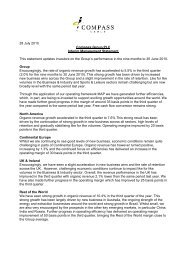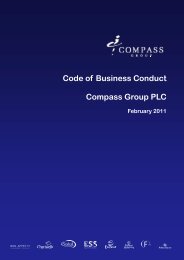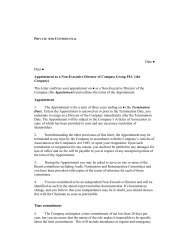2568.11 kb - Compass Group
2568.11 kb - Compass Group
2568.11 kb - Compass Group
Create successful ePaper yourself
Turn your PDF publications into a flip-book with our unique Google optimized e-Paper software.
45 <strong>Compass</strong> <strong>Group</strong> PLC Annual Report 2007Accounting policiesfor the year ended 30 September 2007IntroductionThe significant accounting policies adoptedin the preparation of the <strong>Group</strong>’s financialstatements are set out below:A Accounting convention and basisof preparationThe financial statements have beenprepared in accordance with InternationalFinancial Reporting Standards (‘IFRS’)and International Financial ReportingInterpretations Committee (‘IFRIC’)interpretations as adopted by the EuropeanUnion at 30 September 2007 and with thoseparts of the Companies Act 1985 applicableto companies reporting under IFRS. Theyhave been prepared under the historical costconvention as modified by the revaluationof certain financial instruments.Certain new standards, amendments andinterpretations to existing standards havebeen published that are mandatory for the<strong>Group</strong>’s accounting period beginning on1 October 2007 or later periods. The <strong>Group</strong>has identified IFRS 7 ‘Financial Instruments:Disclosures’, IFRS 8 ‘Operating Segments’,IAS 1 ‘Presentation of Financial Statements’(revised 2007), IFRIC 11 ‘IFRS 2 <strong>Group</strong> andTreasury Share Transactions’ and IFRIC 12‘Service Concession Arrangements’ as beingrelevant to its business but the <strong>Group</strong> has notadopted these early. The <strong>Group</strong> does notanticipate that any of these standards andinterpretations would have a material impacton the <strong>Group</strong>’s financial statements.IFRIC 14 ‘IAS 19 The Limit on aDefined Benefit Asset, Minimum FundingRequirements and their Interaction’ is notmandatory for the <strong>Group</strong>’s accounting periodending 30 September 2007, but has beenadopted early. The <strong>Group</strong> has not recognisedactuarial surpluses of £92 million arising ondefined benefit obligations in its accounts forthe year ended 30 September 2007.B Use of assumptions and estimatesThe preparation of the consolidated financialstatements requires management to makejudgements, estimates and assumptions thataffect the application of policies and reportedamounts of assets and liabilities, income andexpenses. These estimates and assumptionsare based on historical experience and otherfactors that are believed to be reasonableunder the circumstances. Actual results maydiffer from these estimates. The estimates andassumptions that have a significant risk ofcausing a material adjustment to the carryingvalue of assets and liabilities in the nextfinancial year are discussed below.Income taxesThe <strong>Group</strong> is subject to income taxes innumerous jurisdictions. Significant judgementis required in determining the worldwideprovision for income taxes as there are manytransactions and calculations for which theultimate tax determination is uncertain duringthe ordinary course of business. The <strong>Group</strong>recognises liabilities based on estimates ofwhether additional taxes will be due. Wherethe final tax outcome of these matters isdifferent from the amounts that were initiallyrecorded, such differences will impact theresults for the year and the respective incometax and deferred tax provisions in the year inwhich such determination is made.GoodwillThe <strong>Group</strong> tests annually whether goodwillhas suffered any impairment in accordancewith the accounting policy set out in sectionM below. The recoverable amounts of cashgenerating units have been determined basedon value in use calculations. These calculationsrequire the use of estimates and assumptionsconsistent with the most up-to-date budgetsand plans that have been formally approvedby management. The key assumptions usedfor the value in use calculations are set out innote 10 to the financial statements.Post employment benefitsDefined benefit schemes are reappraisedannually by independent actuaries based onactuarial assumptions. Significant judgementis required in determining these actuarialassumptions. The principal assumptions used aredescribed in note 23 to the financial statements.C Basis of consolidationThe consolidated financial statementsconsist of the financial statements of theCompany, entities controlled by the Company(its subsidiaries) and the <strong>Group</strong>’s share ofinterests in joint ventures and associates madeup to 30 September each year.D Subsidiaries, associates andjoint venturesSubsidiariesSubsidiaries are entities over which the <strong>Group</strong>has the power to govern the financial andoperating policies. The existence and effectof potential voting rights that are currentlyexercisable or convertible are consideredwhen assessing control.Joint venturesJoint ventures are entities in which the <strong>Group</strong>holds an interest on a long-term basis andwhich are jointly controlled by the <strong>Group</strong> andother venturers under a contractualagreement. The <strong>Group</strong>’s share is accountedfor using the proportionate consolidationmethod. The consolidated income statementand balance sheet include the <strong>Group</strong>’s shareof the income, expenses, assets and liabilities.AssociatesAssociates are undertakings that are notsubsidiaries or joint ventures over which the<strong>Group</strong> has significant influence and canparticipate in financial and operating policydecisions. Investments in associatedundertakings are accounted for using theequity method. The consolidated incomestatement includes the <strong>Group</strong>’s share of theprofit after tax of the associated undertakings.Investments in associates include goodwillidentified on acquisition and are carried inthe <strong>Group</strong> balance sheet at cost plus postacquisitionchanges in the <strong>Group</strong>’s shareof the net assets of the associate, less anyimpairment in value.AdjustmentsWhere necessary, adjustments are madeto the financial statements of subsidiaries,associates and joint ventures to bring theaccounting policies used in line with thoseused by the <strong>Group</strong>.Acquisitions and disposalsThe results of subsidiaries, associates orjoint ventures acquired or disposed of duringthe period are included in the consolidatedincome statement from the effective dateof acquisition or up to the effective date ofdisposal, as appropriate.Intra-group transactionsAll intra-group transactions, balances, incomeand expenses are eliminated on consolidation.Where a <strong>Group</strong> subsidiary transacts with ajoint venture of the <strong>Group</strong>, profits or lossesare eliminated to the extent of the <strong>Group</strong>’sinterest in the relevant joint venture.E AcquisitionsThe acquisition of subsidiaries is accountedfor using the purchase method. The costof acquisition is measured at the aggregateof the fair values, at the date of exchange,of assets given, liabilities incurred or assumed,and equity instruments issued plus costsdirectly attributable to the acquisition.Identifiable assets acquired and liabilitiesand contingent liabilities assumed arerecognised at the fair values at the acquisitiondate, except for non-current assets (or disposalgroups) that are classified as held for salewhich are recognised and measured at fairvalue less costs to sell.The cost of the acquisition in excess of the<strong>Group</strong>’s interest in the net fair value of theidentifiable net assets acquired is recordedas goodwill. If the cost of the acquisition isless than the fair value of the net assets ofthe subsidiary acquired, the difference isrecognised directly in the income statement.








